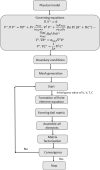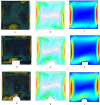FEM simulations for double diffusive transport mechanism hybrid nano fluid flow in corrugated enclosure by installing uniformly heated and concentrated cylinder
- PMID: 38191791
- PMCID: PMC10774439
- DOI: 10.1038/s41598-023-50659-3
FEM simulations for double diffusive transport mechanism hybrid nano fluid flow in corrugated enclosure by installing uniformly heated and concentrated cylinder
Abstract
Generation of fluid flow due to simultaneous occurrence of heat and mass diffusions caused by buoyancy differences is termed as double diffusion. Pervasive applications of such diffusion arise in numerous natural and scientific systems. This article investigates double diffusion in naturally convective flow of water-based fluid saturated in corrugated enclosure and containing hybrid nano particles composed of Copper (Cu) and Alumina (Al2O3). Impact of uniformly applied magnetic field is also accounted. To produce thermosolutal convective potential circular cylinder of constant radius is also adjusted by providing uniform temperature and concentration distributions. Finite element approach is capitalized to provide solution of utilized governing equations by utilizing Multiphysics COMSOL software. Wide-range of physical parameters are incorporated to depict their influence on associated distributions (velocity, temperature and concentration). Interesting physical quantities like Nusselt number, Sherwood numbers are also calculated against involved sundry parameters. It is note worthily observed that maximum strength of stream lines [Formula: see text] is 3.3 at [Formula: see text] and drops to 1.2 when [Formula: see text] is increased to 0.04. Furthermore, in the hydrodynamic case (Ha = 0), it is observed that the velocity field exhibits an increasing trend compared to the hydromagnetic case [Formula: see text] which is proved from the attained values of stream-function i.e., [Formula: see text] (in the absence of a magnetic field) and [Formula: see text] (in the presence of a magnetic field). It is revealed from the statistics of Nusselt number that increase in volume fraction of nano particles from 0 to 0.4, heat flux coefficient upsurges up to 7% approximately. Since, present work includes novel physical aspects of thermosolutal diffusion generated due to induction of hybrid nanoparticles in water contained in corrugated enclosure, so this study will provide innovative thought to the researchers to conduct research in this direction.
© 2024. The Author(s).
Conflict of interest statement
The authors declare no competing interests.
Figures













References
-
- Sezai I, Mohamad AA. Double diffusive convection in a cubic enclosure with opposing temperature and concentration gradients. Phys. Fluids. 2000;12(9):2210–2223. doi: 10.1063/1.1286422. - DOI
-
- Gebhart B, Pera L. The nature of vertical natural convection flows resulting from the combined buoyancy effects of thermal and mass diffusion. Int. J. Heat Mass Transf. 1971;14(12):2025–2050. doi: 10.1016/0017-9310(71)90026-3. - DOI
-
- Nishimura T, Wakamatsu M, Morega AM. Oscillatory double-diffusive convection in a rectangular enclosure with combined horizontal temperature and concentration gradients. Int. J. Heat Mass Transf. 1998;41(11):1601–1611. doi: 10.1016/S0017-9310(97)00271-8. - DOI
-
- Snoussi LB, Chouikh R, Guizani A. Numerical study of the natural convection flow resulting from the combined buoyancy effects of thermal and mass diffusion in a cavity with differentially heated side walls. Desalination. 2005;182(1–3):143–150. doi: 10.1016/j.desal.2005.03.014. - DOI
-
- Chouikh R, Snoussi LB, Guizani A. Numerical study of the heat and mass transfer in inclined glazing cavity: Application to a solar distillation cell. Renew. Energy. 2007;32(9):1511–1524. doi: 10.1016/j.renene.2006.07.001. - DOI
LinkOut - more resources
Full Text Sources

